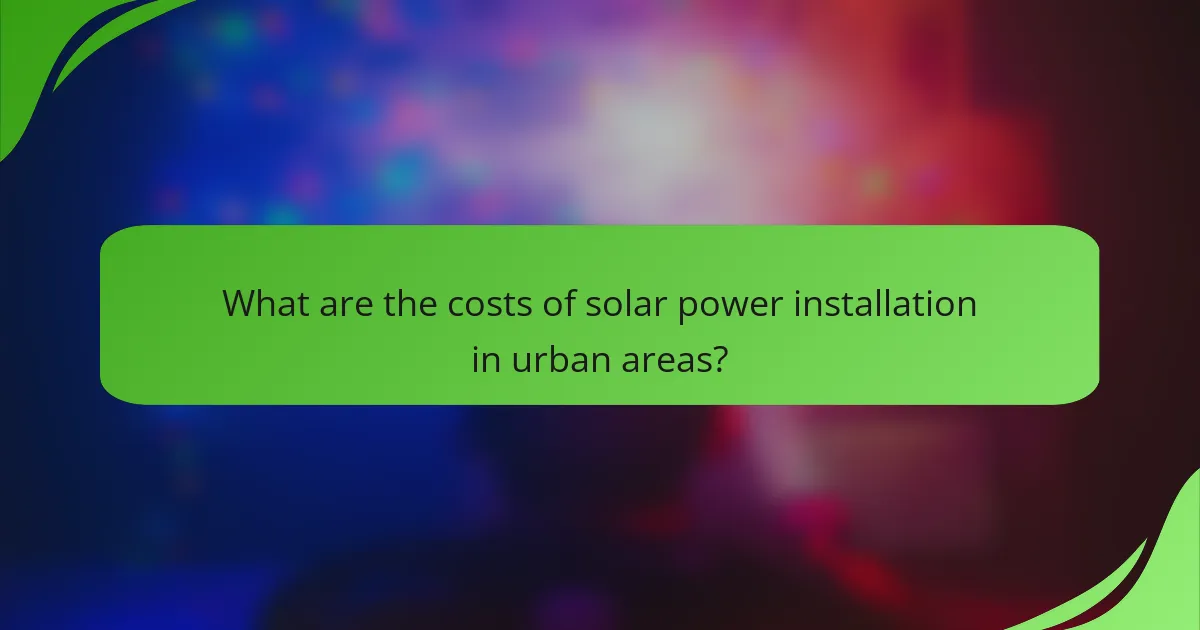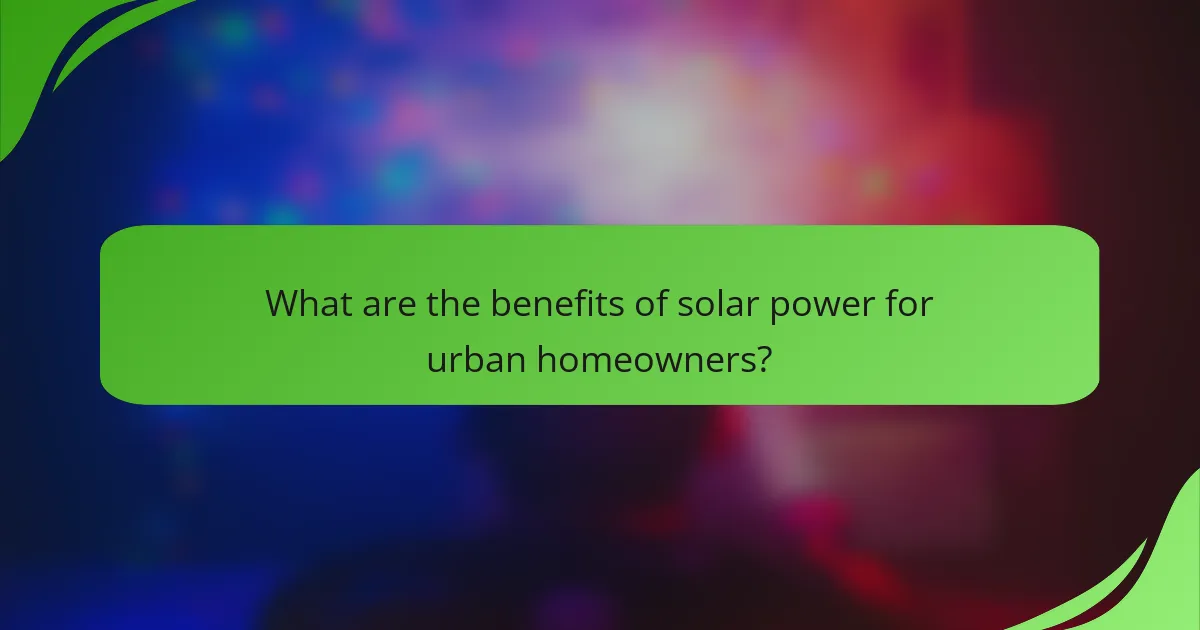Budgeting for solar power installation in urban areas requires careful consideration of various factors, including system size, local incentives, and installation complexity, with costs typically ranging from several thousand to tens of thousands of dollars. Homeowners and businesses can explore multiple financing options, such as federal tax credits and tailored loan arrangements, to facilitate the transition to renewable energy. Selecting a reputable solar provider is essential, as it ensures quality service and support tailored to the unique challenges of urban environments.

What are the costs of solar power installation in urban areas?
The costs of solar power installation in urban areas can vary significantly, typically ranging from several thousand to tens of thousands of dollars. Factors such as system size, local incentives, and installation complexity play a crucial role in determining the final price.
Average installation costs
On average, residential solar power installation costs in urban areas can range from about $15,000 to $30,000 before any tax credits or incentives. This average includes both equipment and labor costs, with prices generally falling between $2.50 and $4.00 per watt. Larger systems may benefit from economies of scale, potentially lowering the cost per watt.
In some cases, financing options such as solar loans or leases can help spread the upfront costs over time, making solar more accessible for homeowners. It’s essential to evaluate these options based on long-term savings and interest rates.
Factors affecting costs
Several factors influence the costs of solar power installation in urban settings. Local regulations, permitting fees, and the availability of incentives can significantly impact the overall price. Additionally, the type of solar panels selected, whether monocrystalline or polycrystalline, can lead to variations in costs.
The complexity of the installation site also plays a role; rooftops that are difficult to access or require structural modifications may incur higher labor costs. Urban areas with limited space may necessitate more innovative solutions, such as solar canopies or community solar projects, which can also affect pricing.
Cost comparison by city
Cost comparisons for solar installation can vary widely by city due to local market conditions and incentives. For example, cities like San Francisco and Los Angeles may have higher installation costs, averaging around $3.50 per watt, while areas in the Midwest, such as Chicago, might see lower averages closer to $2.80 per watt.
It’s beneficial to research local solar providers and obtain multiple quotes to understand the pricing landscape in your city. Additionally, checking for state-specific incentives and rebates can help reduce overall costs significantly.

What financing options are available for solar power?
Several financing options exist for solar power installations, making it easier for homeowners and businesses to adopt renewable energy. These options include federal tax credits, state incentives, and various loan and lease arrangements tailored to fit different financial situations.
Federal tax credits
Federal tax credits provide a significant financial incentive for solar power installations. The Investment Tax Credit (ITC) allows homeowners to deduct a percentage of the cost of their solar system from their federal taxes, making solar more affordable. As of 2023, this credit is set at 30% of the installation costs, which can lead to substantial savings.
To take advantage of this credit, ensure your solar system is installed by a qualified provider and that you file the appropriate IRS forms when you submit your tax return. Keep in mind that this credit is set to decrease in the coming years, so acting sooner can maximize your savings.
State incentives
Many states offer additional incentives to further reduce the cost of solar power installations. These can include rebates, tax credits, and performance-based incentives that pay you for the energy your solar system generates. Each state has its own set of programs, so it’s essential to research what is available in your area.
For example, states like California and New York have robust incentive programs that can significantly lower upfront costs. Check your state’s energy office or local utility company for specific details and eligibility requirements to ensure you benefit from these programs.
Solar loans and leases
Solar loans and leases provide flexible financing options for those who may not want to pay upfront for a solar power system. With solar loans, you can borrow money to purchase the system, allowing you to pay it off over time while enjoying immediate energy savings. Interest rates can vary, so shop around for the best terms.
Alternatively, solar leases allow you to pay a fixed monthly fee to use the solar system without owning it outright. This can be a good option for those who prefer lower upfront costs. However, be aware that you may miss out on tax credits and incentives since you do not own the system. Evaluate your financial situation and energy goals to determine the best option for you.

How to choose the right solar provider in urban areas?
Choosing the right solar provider in urban areas involves evaluating their reputation, service offerings, and customer feedback. Focus on providers with a strong track record and comprehensive services tailored to urban settings.
Provider reputation
Provider reputation is crucial when selecting a solar company. Look for companies with a long history in the industry and certifications from recognized organizations. Local affiliations and partnerships can also indicate a commitment to the community.
Check if the provider has been involved in any legal disputes or complaints, as this can affect their reliability. A solid reputation often correlates with quality service and customer satisfaction.
Service offerings
Evaluate the range of services offered by solar providers. Some may specialize in residential installations, while others might provide commercial solutions or maintenance services. Ensure the provider can meet your specific needs, whether it’s installation, financing options, or energy storage solutions.
Consider whether they offer customized solar solutions that fit the unique challenges of urban environments, such as limited roof space or shading from nearby buildings. A provider that offers a comprehensive package can save you time and effort in the long run.
Customer reviews
Customer reviews provide insight into the experiences of others with the solar provider. Look for feedback on platforms like Google, Yelp, or specialized solar review sites. Pay attention to comments about installation quality, customer service, and post-installation support.
High ratings and positive testimonials can indicate a trustworthy provider, while consistent negative feedback may signal potential issues. Aim to read a mix of reviews to get a balanced perspective on the provider’s performance.

What are the benefits of solar power for urban homeowners?
Solar power offers urban homeowners significant advantages, including reduced energy costs, a positive environmental impact, and increased property values. By harnessing sunlight, homeowners can lower their electricity bills while contributing to a cleaner planet.
Energy savings
One of the primary benefits of solar power for urban homeowners is the potential for substantial energy savings. By installing solar panels, homeowners can generate their own electricity, which can significantly reduce or even eliminate their monthly utility bills. In many urban areas, the return on investment can be realized within a few years, especially with available tax incentives and rebates.
Homeowners should consider their energy consumption patterns and local electricity rates when evaluating solar options. A typical residential solar installation can offset around 50-80% of energy costs, depending on system size and sunlight exposure.
Environmental impact
Solar power contributes to a significant reduction in greenhouse gas emissions, making it an environmentally friendly choice for urban homeowners. By utilizing renewable energy, homeowners can decrease their reliance on fossil fuels, which are major contributors to air pollution and climate change.
In urban settings, where air quality can be a concern, switching to solar energy can help improve local environmental conditions. Additionally, many cities have sustainability goals that encourage the adoption of renewable energy sources, further supporting the transition to solar power.
Increased property value
Installing solar panels can enhance the value of a home, making it more attractive to potential buyers. Studies have shown that homes with solar energy systems often sell for more than comparable homes without solar, as buyers recognize the long-term savings and environmental benefits.
In urban markets, where property values can fluctuate, the addition of solar panels can provide a competitive edge. Homeowners should consider consulting local real estate experts to understand how solar installations can impact their specific property values in their area.

What are the common challenges of solar installation in cities?
Solar installation in urban areas often faces challenges such as limited space and complex regulations. These factors can significantly impact the feasibility and cost-effectiveness of solar projects.
Space limitations
Urban environments typically have restricted roof space, which can limit the size and efficiency of solar panel installations. Many buildings may not have adequate area to accommodate enough panels for significant energy generation.
Additionally, shading from nearby structures can reduce solar efficiency. Homeowners and businesses should assess their roof orientation, angle, and surrounding obstructions to determine the potential for solar energy capture.
Regulatory hurdles
Solar installations in cities often encounter regulatory challenges, including zoning laws and building codes that may restrict the type or size of solar systems. Local governments may require permits, which can add time and costs to the installation process.
It’s crucial to research local regulations and engage with municipal authorities early in the planning phase. Understanding incentives, rebates, and any restrictions can help streamline the installation process and avoid costly delays.
